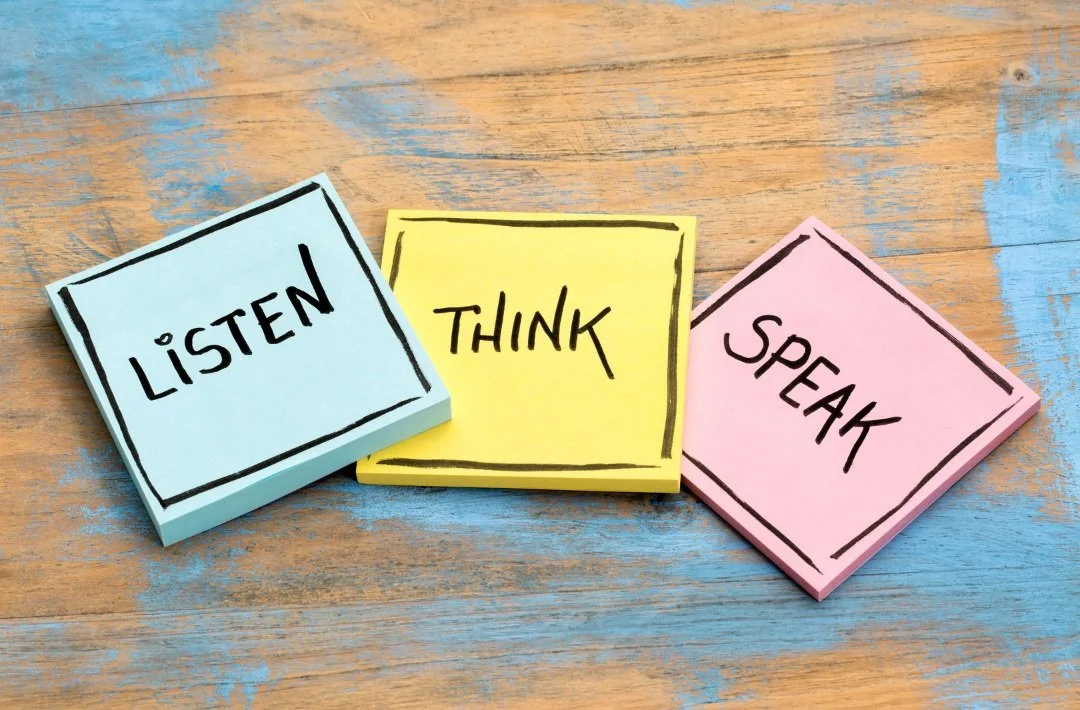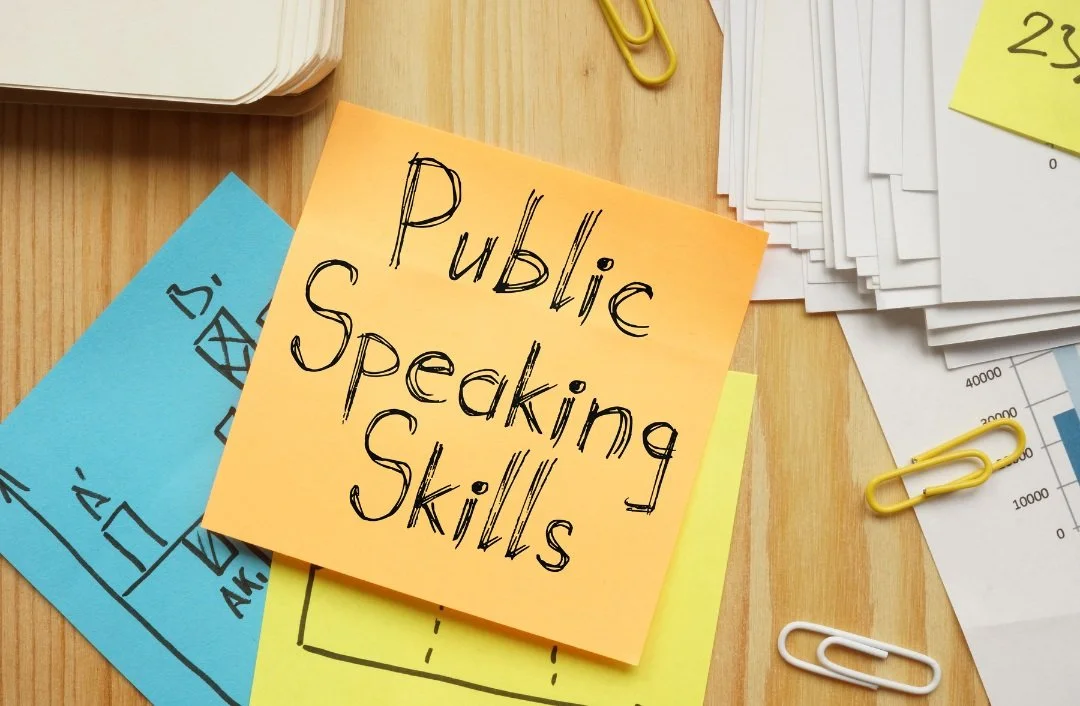Tips to Calm Presentation Anxiety Before Speaking
Have you ever found yourself with sweaty palms, a dry mouth, and an increased heart rate before giving a big presentation? If so, you're not alone. Presentation anxiety and the fear of public speaking affect many people, even seasoned professionals. But here's the good news: The following strategies can transform those pre-presentation nerves into your greatest ally.
Let's Reframe the Narrative
First, let's tackle something important: that nervous energy you're feeling in front of a group of people? It's actually a natural response — your body's way of preparing for something significant. Instead of viewing it as stage fright or social anxiety symptoms, think of it as your body giving you two precious gifts: energy and focus.
I had a client who came to me in a panic about a new job requiring regular presentations. "I'm terrible at presenting," he insisted. "I freeze up, my voice quivers, and everyone can see how nervous I am."
But here's where it gets interesting. When we watched recordings of his presentations (something he'd been avoiding like the plague), he was shocked. Those physical manifestations of nervousness that felt so obvious to him? Barely noticeable to the audience. This led to what became his personal mantra: "WATCH THE TAPE" — a reminder that our perception of our performance often differs drastically from reality.
This relates to what psychologists call the spotlight effect — our tendency to overestimate how much others detect our supposed flaws and mistakes. Trust me, those minor stumbles that feel like massive failures to you often go completely unnoticed by your audience members.
A Mindset Shift: From Performance to Communication
Shifting your mindset is one of the most effective ways to combat presentation anxiety. Stop thinking of it as a performance where the audience judges you. Instead, adopt what I call a "communication mindset."
Here's the simple truth: You have information your audience wants or needs. Your job isn't to put on a show — it's to share that important information effectively. This shift in perspective can be transformative and doesn’t necessarily take a long time to implement.
Think about it this way: When you're having a casual conversation with a family member about a topic you know well, you don't experience the same fear of judgment or social anxiety, right? That's because you're focused on sharing information in your social interactions, not performing.
Practical Strategies for Managing Nervousness
The Power of Preparation
Let's talk about practice runs before speaking in front of others — and not just running through your PowerPoint slides in your head. I recommend what I call the "Triple Threat" approach:
Practice in front of a mirror to work on body language
Record yourself to assess tone of voice and delivery
Present in front of friends or a family member for constructive feedback
Remember: Elite athletes don't just show up on game day and hope for the best. They practice until their performance becomes second nature.
Vocal Warm-ups and Body Preparation
Before any big presentation, treat your voice like the instrument it is. Here's a comprehensive warm-up routine:
Face and Jaw:
Massage your facial muscles, particularly where you hold tension
Alternate between "big face" (eyes and mouth open wide) and "small face" (scrunched)
Stretch your face in all directions: up, down, left, and right
Shake out your jaw until it’s completely relaxed
Neck and Throat:
Drop your ear to your shoulder and extend the opposite arm
Draw small circles in both directions
Forward head rolls with gentle finger pressure
Shoulder raises and drops for tension release
Lips and Tongue:
Massage above the upper lip and below the lower lip
Blow through your lips with and without sound
Practice tongue exercises (up, down, left, right, and in circles)
Try trills with your lips and tongue
Practice going from "Nnnnnggggg” to “aaahhhhh" for palate engagement
Explode "K" sounds for articulation
2. Breathing Techniques That Actually Work
When experiencing presentation anxiety, your flight response kicks in, often leading to shallow breathing. Here are some mindfulness techniques that can help you breathe easy and keep negative thoughts at bay:
Diaphragmatic breathing: Place one hand on your chest and one on your belly. Take deep breaths that make your belly expand, not your chest.
The "4-7-8" technique: Breathe in for 4 counts, hold for 7, and exhale for 8. This helps regulate stress hormones and blood pressure.
The power of the pause: During your presentation, don't be afraid of strategic pauses. They give you time to collect your thoughts and appear more confident.
Physical Preparation and Advanced Breathwork
Looking for more breathwork tips and tricks? Let's dive into some game-changing techniques that can transform your presentation delivery. First up: deep breathing exercises. I learned this fascinating technique from a real-life monk. It's called "straw breathing," and it's remarkably effective:
Inhale deeply through your nose
Make your lips small and round (about the size of a straw)
Exhale slowly, as if blowing through that straw
Here's why this works: When your exhale is longer than your inhale, your heart rate physically cannot maintain an elevated state. It's biological programming at its finest.
For even deeper mindful breathing work:
Expand your thoracic cavity and fill your chest
Take a second breath if you need it
Pay attention to the intercostal muscles between your ribs
Practice controlled releases (try a 7-count exhale)
Remember that controlled breath release is unique to humans — use this superpower!
3. Pre-Presentation Rituals
Just like professional athletes have pre-game routines, developing a ritual for your own presentations can be the best way to center yourself. Here are some options:
Power Poses:
Stand in the "victory pose" (arms raised above head)
Try warrior poses from yoga
Movement:
Take a brief walk
Do some light stretching
Release nervous energy through simple exercises
Remember, these aren't just random activities — they're proven strategies for managing cognitive-behavioral responses to stress.
Connecting with Your Space and Audience
It’s also important to familiarize yourself with the room ahead of your presentation. Following these steps can help you get comfortable in the space.
Arrive early to walk the room
Do a sound check
Focus on three things you like about the space
Take a moment to feel comfortable in the environment
Practice walking your presentation path
Notice something you enjoy visually
Connect with a positive sensation or emotion
Remember that this environment is okay, and so are you
4. Visualization: Your Mental Rehearsal
Here's where many people go wrong: They spend time before a big presentation visualizing everything that could go wrong. Instead, use that mental energy for positive thinking. Create your highlight reel:
Find a quiet spot for positive affirmations and self-talk
Picture yourself delivering key messages with confidence
Imagine making good eye contact with friendly faces
Visualize successfully handling questions
See yourself receiving positive feedback
Finding Your Joy and Energy
Location Energy Exercise:
Identify places where you naturally feel energized (a favorite vacation destination, your gym, etc.)
Analyze what these locations mean to you
Extract the core feelings and energy
Channel these into your presentation style
Authenticity Exercise:
Record yourself answering one of these questions for 30-90 seconds:
What was your favorite trip?
Describe your perfect meal
What's your favorite movie and why?
Notice how naturally you tell these stories — that's your authentic presentation voice!
The Day of Your Presentation
Setting Yourself Up for Success
On presentation day, focus on these practical tips:
Arrive at the presentation venue early
Test any visual aids or PowerPoint slides beforehand
Have water ready to combat a dry throat
Scan the room and get comfortable in the space
If it's a video conference or video call, test your tech in advance
2. Managing the Present Moment
When you're in front of an audience, remember these truths:
Most audience members want you to succeed
They're typically more focused on the content of your presentation than your delivery
If you make a mistake, keep going — most people won't even notice
3. Channel Your Energy
Remember that an increased heart rate and stress hormones aren't your enemies — they're preparing you for a big performance. A runner at the starting line of a marathon experiences similar physical symptoms. They're not signs of weakness — they're signs of readiness.
Advanced Strategies for Long-Term Growth
Build Your Comfort Zone Gradually
Start with these smaller opportunities to speak in front of people and gradually work your way up:
Team meetings
Small group presentations
Department updates
Eventually, larger live events
2. Collect Evidence of Success
Keep a record of your past successes. After each presentation, write down the elements that made it a successful speech:
Three things that went well
Important points you communicated effectively
Positive feedback you received
One area for improvement next time
3. Professional Development
Consider working with a public speaking coach or joining organizations like Toastmasters. You can even take cognitive-behavioral therapy sessions if the fear of judgment or social interaction causes you significant distress.
The Bottom Line
Remember my client who was terrified of presentations? By implementing these strategies and focusing on the most important points rather than his fear, he became one of the most confident speakers in his organization. The secret wasn't eliminating nervousness — it was learning to work with it.
Here's a simple act you can take right now: Instead of labeling your pre-presentation feelings as "nervousness," call them "preparation energy" or "performance readiness." This small shift in terminology can go a long way in changing your relationship with public speaking.
Final Thoughts
When you're preparing for your next presentation, remember:
Your audience wants you to succeed
Those physical symptoms are your allies
Focus on communication, not performance
You likely appear more confident than you feel
Every great presenter started somewhere
Being nervous before a speech isn't a bad thing — it's often the first step toward giving a successful presentation. With these strategies and mindfulness techniques, you can transform that nervous energy into your greatest asset.
What's on the other side of your fear? Maybe it's a promotion, increased confidence, or the ability to influence and inspire others. Keep that in mind as your true north, and let it guide you in the right direction.
Remember, even TED Talk speakers get nervous. The difference is, they've learned a great way to make those butterflies fly in formation.
If you’d like personalized coaching for presentation preparation, reserve a time on my calendar for a free intro call! I can walk you through any of the concepts in this article and help you internalize them for success.
Are you ready to transform your presentation anxiety into presentation mastery? Your next opportunity could be the one where everything changes.
Advanced Techniques for Presentation Excellence
The Green Zone Technique
Think of your presentation state like a traffic light. You want to stay in the "green zone" where:
You're connected to your message
You control your breathing
Your throat is open
Your focus is outward toward the audience, not inward on yourself
When you feel yourself slipping into the "red zone" (characterized by vocal fry, filler words, and inward focus), use the P.R.E.P. method:
Point: State your main idea
Reason: Explain why it matters
Example: Provide a concrete illustration
Point: Circle back to reinforce your message
Addressing Specific Challenges
For Those Who Ramble:
Set a timer face down
Give yourself a specific question to answer
Practice being concise and clear
Time yourself and adjust accordingly
For Fast Talkers:
Practice speaking slowly
Use short, simple sentences
Avoid filler words
Maintain a steady pace throughout
Imagine words as molasses falling from your mouth
For Monotone Speakers:
Practice the trinity:
High-low: Vary your pitch
Fast-slow: Change your tempo
Stop-go: Use strategic pauses
For Those Who Sound Unsure:
Pick a topic you know nothing about (like nuclear fission)
Speak about it with complete authority for one minute
Pretend you're the world's leading expert
Practice owning your space and voice
Mindset Shifts for Success
Replace self-focused questions like "How am I doing?" with audience-focused thoughts:
What value can I provide?
How can I make this clearer?
What does my audience need?
Joy and Enthusiasm:
Say aloud: "I'm thrilled to be here"
Remind yourself: It’s "I get to do this" not “I have to do this”
Allow yourself to enjoy the experience
Don't cap your potential for a good experience
Raise your joy tolerance threshold
Remember:
Nerves are not a predictor of performance
It’s okay to be uncomfortable
Focus on clarity over perfection
Smiling changes your biochemistry
Connect with your genuine excitement about the topic
The key is to actually feel these words as you say them. When you combine physical preparation, mental clarity, and genuine enthusiasm, you create a powerful presentation experience for both yourself and your audience. I hope these tips and tricks will help you overcome your phobia of public speaking!
About The Author
Emily Sander is a C-suite executive turned leadership coach. Her corporate career spanned Fortune 500 companies and scrappy start-ups. She is an ICF-certified leadership coach and the author of two books, An Insider’s Perspective on the Chief of Staff and Hacking Executive Leadership.
Emily works with early to senior executives to step into effective leadership with one-on-one coaching. Go here to read her story from seasoned executive to knowledgeable coach.






